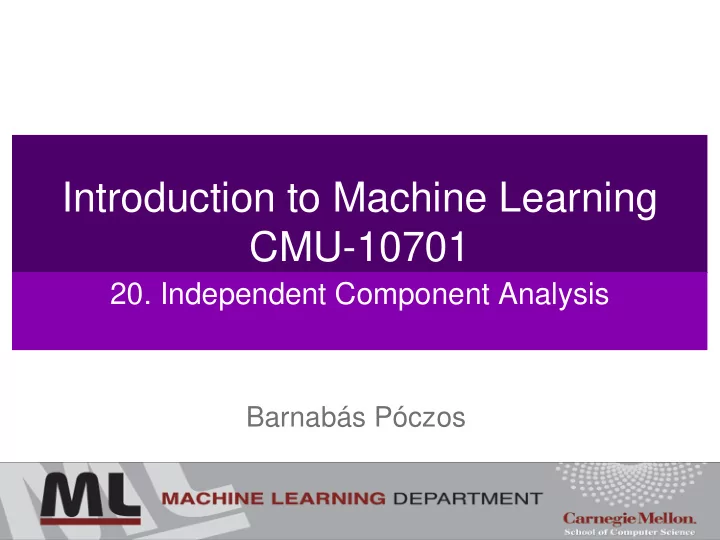

Introduction to Machine Learning CMU-10701 20. Independent Component Analysis Barnabás Póczos
Contents ICA model ICA applications ICA generalizations ICA theory 2
Independent Component Analysis 3
Independent Component Analysis Goal: 4
Independent Component Analysis Model Observations (Mixtures) original signals ICA estimated signals 5
Independent Component Analysys Model We observe We want Goal: 6
ICA vs PCA, Similarities • Perform linear transformations • Matrix factorization PCA : low rank matrix factorization for compression S M<N N U X = M ICA : full rank matrix factorization to remove dependency among the rows S A X N = 7 N
ICA vs PCA, Similarities PCA: X=US, U T U=I ICA: X=AS PCA does compression M<N • ICA does not do compression same # of features (M=N) • PCA just removes correlations, not higher order dependence ICA removes correlations, and higher order dependence PCA: some components are more important than others (based on eigenvalues) ICA: components are equally important 8
ICA vs PCA Note • PCA vectors are orthogonal • ICA vectors are not orthogonal 9
ICA vs PCA 10
The Cocktail Party Problem SOLVING WITH PCA Sources Observation PCA Estimation Mixing x(t) = As(t) y(t)=Wx(t) s(t) 11
The Cocktail Party Problem SOLVING WITH ICA Sources Observation ICA Estimation Mixing x(t) = As(t) y(t)=Wx(t) s(t) 12
Some ICA Applications TEMPORAL STATIC • Image denoising • Medical signal processing – fMRI, ECG, EEG • Microarray data processing • Brain Computer Interfaces • Decomposing the spectra of • Modeling of the hippocampus, galaxies place cells • Face recognition • Modeling of the visual cortex • Facial expression recognition • Time series analysis • Feature extraction • Financial applications • Clustering • Blind deconvolution • Classification • Deep Neural Networks 13
ICA Application, Removing Artifacts from EEG EEG ~ Neural cocktail party Severe contamination of EEG activity by • eye movements • blinks • muscle • heart, ECG artifact • vessel pulse • electrode noise • line noise, alternating current (60 Hz) ICA can improve signal • effectively detect, separate and remove activity in EEG records from a wide variety of artifactual sources. (Jung, Makeig, Bell, and Sejnowski) ICA weights help find location of sources 14
ICA Application, Removing Artifacts from EEG 15 Fig from Jung
Removing Artifacts from EEG 16 Fig from Jung
ICA for Image Denoising original noisy Wiener filtered ICA denoised (Hoyer, Hyvarinen) median filtered 17 17
ICA for Motion Style Components Method for analysis and synthesis of human motion from motion captured data Provides perceptually meaningful components 109 markers, 327 parameters ) 6 independent components (emotion, content,…) (Mori & Hoshino 2002, Shapiro et al 2006, Cao et al 2003) 18
walk sneaky sneaky with walk walk with sneaky 19 19
ICA basis vectors extracted from natural images Gabor wavelets, edge detection, receptive fields of V1 cells... 20
PCA basis vectors extracted from natural images 21
ICA Theory 22
Basic terms, definitions uncorrelated and independent variables entropy, joint entropy, negentropy mutual information Kullback-Leibler divergence 23
Statistical (in)dependence Definition: Definition: Lemma: Proof: Homework 24
Correlation Definition: Lemma: Proof: Homework Lemma: Proof: Homework Lemma: Proof: Homework 25
Mutual Information, Entropy Definition (Mutual Information) Definition (Shannon entropy) Definition (KL divergence) 26
Solving the ICA problem with i.i.d. sources 27
Solving the ICA problem with i.i.d. sources 28
Whitening Theorem (Whitening) Definitions Note 29
Proof of the whitening theorem 30
Proof of the whitening theorem We can use PCA for whitening! 31
Whitening solves half of the ICA problem Note: The number of free parameters of an N by N orthogonal matrix is (N-1)(N-2)/2. ) whitening solves half of the ICA problem original mixed whitened 32
Solving ICA ICA task: Given x , find y (the estimation of s ), find W (the estimation of A -1 ) ICA solution : y=Wx Remove mean, E[ x ]=0 Whitening, E[ xx T ]= I Find an orthogonal W optimizing an objective function • Sequence of 2-d Jacobi (Givens) rotations rotated original mixed whitened 33 (demixed)
Optimization Using Jacobi Rotation Matrices p q p q 34
Gaussian sources are problematic The Gaussian distribution is spherically symmetric . Mixing it with an orthogonal matrix… produces the same distribution... No hope for recovery... However, this is the only ‘nice’ distribution that we cannot recover! 35
ICA Cost Functions ) go away from normal distribution 36 36
Central Limit Theorem The sum of independent variables converges to the normal distribution ) For separation go far away from the normal distribution ) Negentropy, |kurtozis| maximization 37 37 Figs borrowed from Ata Kaban
ICA Algorithms 38
Algorithms There are more than 100 different ICA algorithms… • Mutual information (MI) estimation • Kernel-ICA [Bach & Jordan, 2002] • Entropy, negentropy estimation • Infomax ICA [ Bell & Sejnowski 1995 ] • RADICAL [Learned-Miller & Fisher, 2003] • FastICA [Hyvarinen, 1999] • [ Girolami & Fyfe 1997 ] • ML estimation • KDICA [Chen, 2006] • EM-ICA [Welling] • [ MacKay 1996; Pearlmutter & Parra 1996; Cardoso 1997 ] • Higher order moments, cumulants based methods • JADE [Cardoso, 1993] • Nonlinear correlation based methods • [Jutten and Herault, 1991] 39
Maximum Likelihood ICA Algorithm rows of W 40 David J.C. MacKay (97)
ICA algorithm based on Kurtosis maximization Kurtosis = 4 th order cumulant Measures • the distance from normality • the degree of peakedness 41
The Fast ICA algorithm (Hyvarinen) Probably the most famous ICA algorithm 42
Independent Subspace Analysis 43
Independent Subspace Analysis Original Mixed Separated Hinton diagram 44
Independent Subspace Analysis Numerical Simulations 2D Letters (i.i.d.) Observation Sources Estimated sources Performance matrix 45
Independent Subspace Analysis 46
Thanks for the Attention! 47
Recommend
More recommend